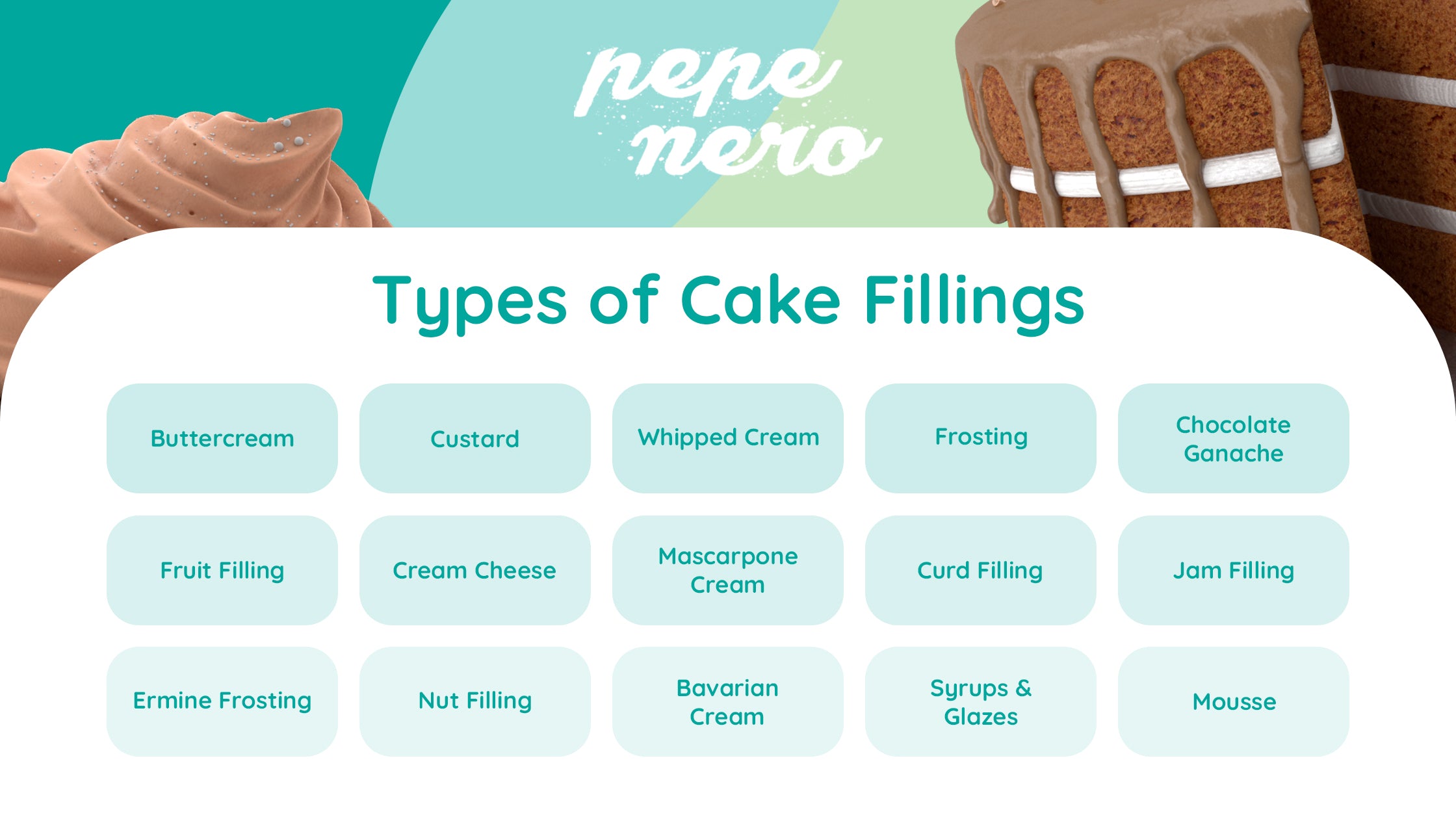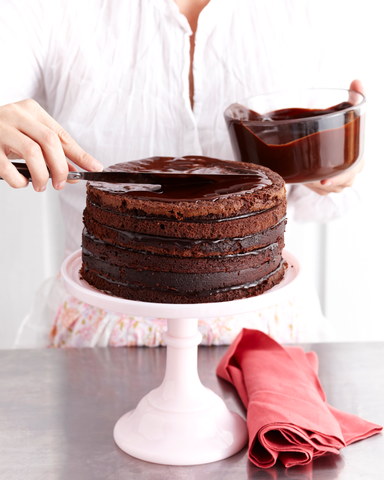Your Cart is Empty
FREE EXPEDITED SHIPPING
Who doesn't love a slice of cake? But let's be real, it's the filling that really makes it special. That sweet, creamy layer in the middle turns a good cake into a great one!
In today's blog, we're diving into the world of cake fillings. We've got 14 amazing types to share with you. These fillings are not just delicious but are sure to take your cake game to the next level.

Cake fillings are thick or thin mixtures that are placed between the layers of a cake. They add flavor, height, and help keep the cake together.

Here are the 14 different types of cake fillings that are used in cakes, ranging from popular ones to not-so-popular ones:

Buttercream is simple to use. Given that it's used to cover a cake, using it as a filling makes sense.
You can find different flavors of buttercream, but chocolate buttercream and Swiss meringue buttercream are the most popular. Here's a tip: the buttercream you use inside the cake doesn't have to be the same as the one you use on the outside. You can mix it up!

Custard is a smooth, pastry cream filling. It is made from flour, sugar, cornstarch, and egg yolks. While you can find it in various flavors, vanilla and chocolate are the usual favorites.

Whipped cream is another filling that is frequently used in cakes. This type of cake filling is popular among beginners. For a simple twist to your regular whipped cream filling, mix melted chocolate to give it a delicious chocolate flavor. This type of cake filling pairs beautifully with a vanilla cake and a dark chocolate cake.

Most birthday cakes use frosting as the main filling. If your cake seems dry, just add some frosting to make it moist again. This filling is usually made with butter, milk, and powdered sugar.

Ganache is a smooth mix of chocolate and heavy cream that pairs nicely with many cakes. To make it extra rich and tasty, use 1.5 parts chocolate for every 1 part of cream.

You can turn various fruits into cake fillings, like blueberries, apricots, strawberries, peaches, raspberries, and rhubarb. When using fruit fillings, you usually put a frosting barrier on the outer cake layer to keep the filling between the layers. If you want to use fresh fruit, it's best to assemble the cake right before serving to keep it fresh.

Cream cheese frosting is loved for its tangy flavor. Even though it's often called a type of buttercream frosting, most of the fat in it comes from cream cheese rather than butter.

Mascarpone has a unique quality that makes it perfect for almost every type of layer cake. This type of cake filling is similar to cream cheese but smoother, sweeter, and less acidic.

You can use curd as a filling by itself or mix it with buttercream to give your cake a unique flavor. Some popular curd flavors include lemon curd, blueberry curd, and strawberry curd.

Jam fillings work nicely when you blend them with other fillings like buttercream or ganache. Before using jam as a filling, just give it a quick whisk to make it smoother, or warm it up a bit if it's too thick. If you want it extra smooth, strain out any seeds.

Ermine frosting is also referred to as "boiled milk" icing. This type of cake filling is light and fluffy and has a texture similar to whipped cream.

If you're a fan of nuts, a tasty nut cake filling is a great choice. It pairs nicely with a chocolate chip cake or banana cake. Nut fillings usually include butter, sugar, flour, and cream, along with your favorite nuts.

Bavarian cream is a bit more complicated to make, but it's incredibly satisfying. It's perfect for no-bake pastries due to its silky, pudding-like consistency, and mild vanilla flavor. It falls between custard and frosting in thickness.

Although they don't provide any thickness, glazes, and syrups can also be used as fillings. They add flavor and keep the cake moist. You can store this kind of filling at room temperature unless the cake needs refrigeration.

Mousses are airy, delicate, and velvety. When using it as a cake filling, the most crucial consideration is that the cake you select shouldn't be excessively dense. You don't want anything to press the mousse out the sides of the cake and weigh it down.

Here's a simple guide on how to layer a cake:
First, bake your cake layers according to your favorite recipe. Let them cool completely before you start layering.
Decide what filling you want to use – it could be frosting, fruit, curd, or anything you like. Make sure it has a spreadable consistency.
If your cake layers have a dome shape on top, you can level them off with a serrated knife or a cake leveler.
Put the first cake layer on your serving plate or cake board. This will be the bottom layer, so make sure it's flat side down.
Now, it's time for the filling. If it's thick, like frosting, pipe a ring of it around the edge of the cake layer. This will make a little "dam" to keep the filling from oozing out.
Spread your chosen filling evenly within the "dam" you made. Don't go right to the edge; leave a little space.
Place the second cake layer on top of the filling. Make sure it's centered and sits evenly on the first layer.
Repeat steps 5 and 6 by adding more filling and spreading it out on the second layer.
Place the final cake layer on top, with the flat side facing up. Your cake is now layered!
If you like, you can frost the outside of the cake with your choice of frosting. Smooth it out for a nice finish.
Get creative and decorate your cake however you want. Sprinkles, fruit, or more frosting – it's your masterpiece!
Now that you have a rough understanding of all the amazing cake fillings out there, it's time to get baking. Shop our complete baking kit to improve your baking skills. It comes with everything you need to bake, including piping bags, piping tips, whisks, turntables, and more.
Comments will be approved before showing up.
